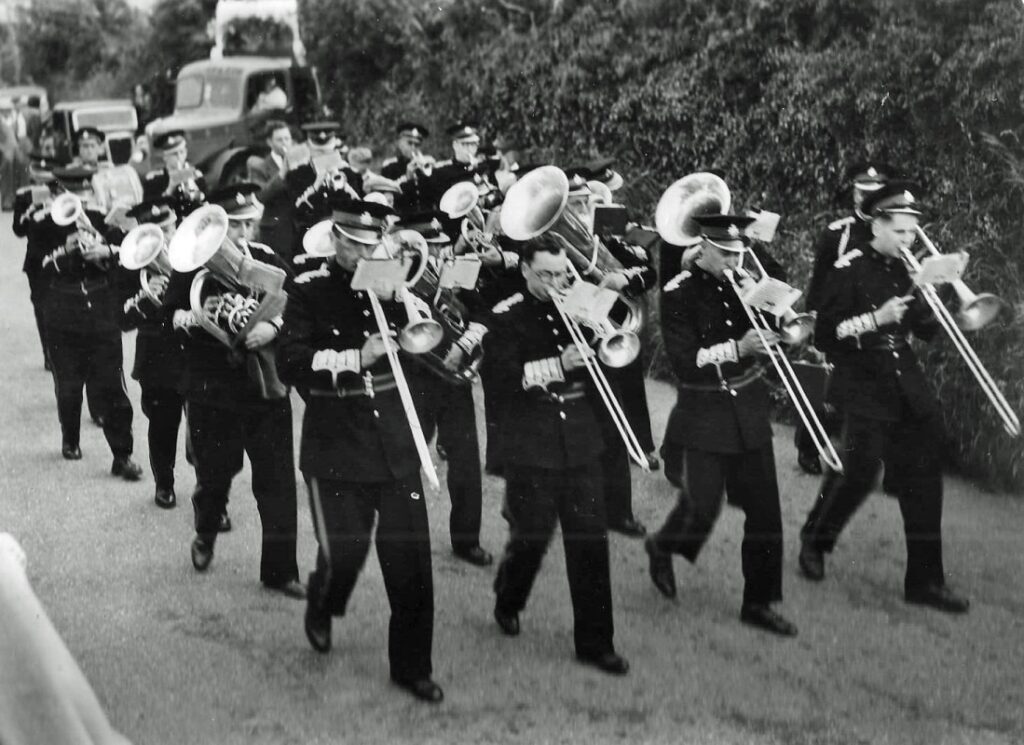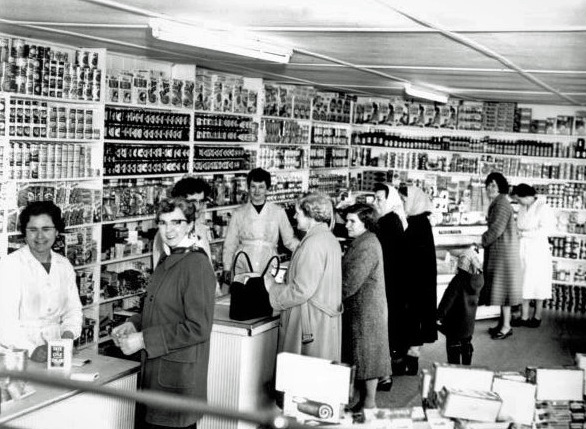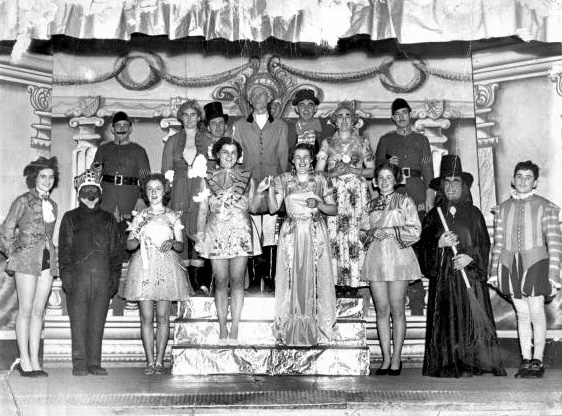This article takes us for a trip into clay-country as Malcolm Gould recalls his young life there in one of its small villages.

I was born at my grandparents’ bungalow in Penwithickin 1956; my father was born there 30 years earlier. The bungalow is situated on the left as you enter Penwithick from the St Austell direction; my parents’ home was almost opposite. My sister and I grew up there and my mother remained in the same house until she passed away in 2016. My father, Tommy, worked for English Clays, Lovering and Pochin (ECLP) as a mechanic and chauffeur; he drove many distinguished visitors including most members of the Royal Family.
Penwithick “Pennwydhek” is situated three miles north of St Austell on the edge of the Hensbarrow granite mass in clay country which lies in the bounds of Treverbyn parish. It was once known as Penwithick Stents as there was early tin streaming in the lee of Carloggas downs. A L Rouse, in his book “A Cornish Childhood” referred to Penwithick as being within “the Higher Quarter”; he would travel with his uncle to visit Mr Sturtridge’s shop and post office. Rouse’s uncle, Mr Rawe, was the local rag man; his Aunt was most unhappy when he was referred to as such.

The village is situated along one road leading to Bugle, now very busy but in the 1960s only a few cars travelled along it. However it was used by many clay lorries transporting their loads from Rocks China clay driers at Bugle to the ports of Par and Fowey. When walking through the village as a boy, I would pick up small pellets of clay which had dropped off the big lorries; I loaded them into my toy lorries in the clay works I had constructed in my parents garden! I had a Triang tin lorry to which I would tie a piece of string and haul it around; my father told me “boy, you’m doing the same as I did”.
The Western National bus number 64 ran through the village from St Austell Station to Bugle; the same company ran a bus which took us to Treverbyn School, adjacent to St Peter the Apostle Church. The fare was sixpence. I remember the conductor’s leather money bags and ticket machine. The conductor was Alex Morris and his driver was Ron Sleeman; both of whom left the buses to work for E.C.L.P. The school has now been converted into tasteful dwellings but a plaque remains on the wall to remind passers-by of its former life. Our playground was opposite, now a parking area for Treverbyn Hall; we used to dance around the Maypole there each spring.
The population of Penwithick today is about 2,000 but growing up in the 1960s it must have been half that. Housing development has grown steadily over the last 60 odd years; Grose Hill Crescent was the first to appear just after the Second World War; followed by the Council houses at the bottom of the village. Road names were Cannamanning, after the area it was built on, Tedder Road, named after Arthur William Tedder 1st Baron. Royal Air Force; Montgomery Road after Bernard Law Montgomery, 1st Viscount of Alamein and Mountbatten Road after Louis Frances Albert Victor Nicholas Mountbatten of Burma. Other developments have sprung up over the last 60 years, I particularly remember a Canadian style timber house appearing at the St Austell end of the village; I had never seen anything like it before although nowadays it’s quite a common sight. Building work will soon start on the proposed Eco-Village at Carludden, 1500 homes are planned as well as a school, community and health facilities. Although there is the narrowest of green corridors remaining between the proposed site and Penwithick, it will inevitably alter the character of my village; “Whatever next”, my mother would say!
Growing up in Penwithick holds happy memories for me; in particular, travelling to work with my grandfather Bill Gould in his lorry, he used to park his Ford Thames Trader in the E.C.L.P. garage lorry park behind our house. The E.C.L.P garage constructed aluminium butts for the Heavy Transport fleet of Lorries. Several drivers employed by Heavy Transport lived in the village and also parked in the yard. Those on the Rocks to Par clay run would often stop off for crib, parking their lorry on the road. It annoyed my mother considerably when a lorry was left outside our house as the front room would go dark.
Opposite the garage was the Penwithick Silver Band room: to my knowledge it was built as a First World War memorial. The band was started in the early 20th century and continued until the late 1950s; it was re-formed again in the early 1970s. My father was a keen bandsman; he started with the band in the late 1940s and although he moved on to play for Bugle Silver Band, he would often return to have a blow for Penwithick; that’s when I started to learn to play the B flat bass. Our band master was Roy Richards from Rescorla; Roy would play the cornet and conduct at the same time. We played in the village at Christmas, also I remember a gymkhana at Rescorla where we played “Wandrin’ Star” and boy, didn’t we wander. One section of the band played one part whilst the rest played another; clearly not enough practice but all good fun!

As boys we would be out playing all day long, riding our bikes, making dillies or playing Cowboys and Indians. We had a fort out on the downs where we spent many happy hours acting out our games. Mother would call to us to come in for dinner or, if we were lucky, a homemade pasty would be put into a paper bag and we would be sent on our way to eat it,. I remember once, an old timer walking down the road looking at me and saying “cut yer ‘an’ boy”? When I checked my hand he laughed and went on his way, what he was referring to was the top of the pasty looking like a brave big cut/ gash!! After finishing our crib we would play football on the green using our pullovers as the goals. There was one star player by the name of Bonzo the dog, he was so expert at dribbling the ball it was as if it ball was stuck to his nose! If we had football boots we wore them, more often we played in our shoes which didn’t do them much good. When they needed to be repaired we would take them to the village cobbler, Harr Rowe; as far as I know repairing shoes was a part time occupation as his main job was at the clay works.
Our village shop and post office was owned and run by Mr Sturtridge whose father owned the shop before him. It was counter service with two or three shop assistants who would go to and fro getting the goods and then totting up the price on a piece of paper. Our gran would send us on errands “down shop”; I was fascinated by the meat slicer and was always warned “Don’t put yer hand too close to the slicer”. Nan would buy groceries from Dick Richards up at Stenalees; he would come in, sit at the kitchen table and take Nan’s order and tell the tale.

One of my treats was when the butcher’s van did its round: the driver would blow the horn and we would ask Nan if we could have some hogs pudding. We would step into the back of the van and slap sixpence on the counter and ask for sixpenneth of hog’s pudding. I don’t think he ever weighed it and, depending how generous he was feeling, you could have a brave old piece or a very small piece! We had a Fish and Chip shop in the village – on the site of the present one; it was a tin shack run by Mr and Mrs Richards; we would get a six of chips and a few pieces of batter if we were lucky.
Penwithick had no pub, the Social Club was opened in 1930s but didn’t gain an alcohol licence ‘till around the 1960s. As an older teenager I would either go there or walk down to the Sawles Arms at Carthew with my mate Paul. If we wanted to see a film we would have to catch a bus to St Austell as Penwithick was limited in what it had to offer in the way of entertainment. However, a pantomime was put on at Christmas for many years; unlike my dad, I didn’t take part but it was a wonderful community event.


As my sister and I were growing up, we were made to go to Sunday school and after we would have to go in the chapel. Like so many others, the chapel has now closed and the building converted to housing, my Nan would be so upset, it was her second home. On the odd occasion I didn’t go to Sunday school, I would go to my grandparents’ just up the road. Summertime I would help Bab, that was the name we always called him, to till his garden. He was more of a veg rather than flower gardener; when he planted teddies he would take out a trench and let me use his pocket knife to cut the teddy in half if it had a couple of chits(1) on it.

(Photo: courtesy Malcolm Gould)
I remember watching him string up the onions he had grown with a piece of twine and hang them in his shed where we would play; one day my gran found us playing at being butchers with some putty and Bab’s bill hook!
Sometimes Uncle Theodore would call by, Nan would be “gone chapel” and Bab would be left in charge of the Sunday dinner; we never called it lunch, ‘twas always dinner. Whilst Bab smoked Woodbines, Uncle Theodore smoked a pipe; I was fascinated by the pipe, he would take a stick of tobacco, cut it with his penknife and rub it in the palms of his hands for the longest time. He would be still telling the tale with his pipe in his mouth, and when necessary, he would stoke up. I used to try to make a cigarette in the same way I had seen cowboys in the movies; by peeling off the silver paper and using the bits of tobacco remaining in the packet. After rolling it up I would ask Bab, “Ave’ee got a light mate?” My Father told my mother what I had done and my sister piped up and asked “did’ee make it come out yer nose like you did down in the field?” there was hell up then!
Penwithick is situated on the eastern fringes of the Hensbarrow granite, tin streaming was active at Cannamanning years before the china clay. The nearest working china clay pits were Baal and West Carclaze. There was an old pit at Hallaze at the bottom of the village, this was worked from the mid-19th century until early to mid-20th century, it was small and although close to the road, it was hidden by trees. The engine house had a rotative engine and can still be seen, it is now owned by South West Water.
To the north of Penwithick is Carloggas Downs; a tipping program started there in the late 1960s for disposing of the waste quartz sand from Gunheath, Wheal Martyn and Penhale pits; this was in operation 24 hours a day, seven days a week. Prior to tipping commencing, an archaeological survey had been commissioned by the clay company. A dig showed the down had been the site of a Bronze Age settlement, a few artefacts were unearthed but nothing substantial, it was recorded and then tipping commenced, covering it in tons of waste. As the tip got higher it seemed the evening sunsets got shorter! Tipping ceased in the 1980s, the tip was re-profiled and returned to heathland similar to before, only a good deal higher; it’s now accessible to the public and has commanding views of St Austell Bay and Bodmin Moor.
I consider myself very lucky to have been born and bred in Penwithick. It was a friendly, close knit working class community; I am proud to still call myself a Penwithick boy!

Malcolm is a Cornish Bard (Map pry gwynn). He has worked in the china clay industry at Imerys, formerly English China Clays, for the last 45 years. Having grown up in the clay district it was the thing to do. He became a member of the China Clay History Society not long after its formation, volunteering at the archive and being asked to understudy one of the members, Harry Woodhouse, Cornish Bard, who looked after the film archive. With work commitments it was difficult to attend the archive on weekdays so he now volunteers at Wheal Martyn Museum in meeting and greeting, giving guided tours and driving an old 1934 ERF lorry. He also visits local groups giving clay related talks and showing films from the archive.